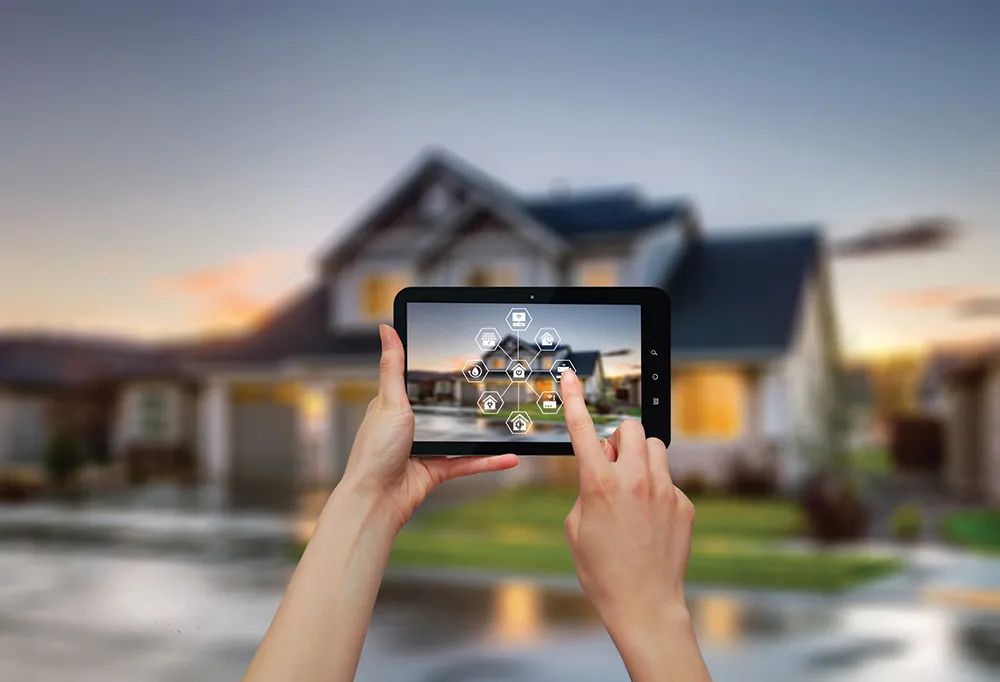
The Next Level of Living: Smart Home Technology
October 2024
by Renata Haidle
Have you ever dreamed of a home that adjusts to your needs before you even ask? One that turns on the lights and warms itself to the desired temperature right before you walk through the front door? A door you open with the touch of a finger, no less? This isn't some sci-fi scenario. It is simply the basic idea behind a smart home, a series of automated routines you can control via apps on your phone, tablet, or smartwatch.
In the last decade, the marketplace has seen the rise of new and innovative devices meant to simplify and improve our lives: lighting sources, outlets, speakers, garage openers, thermostats, window treatments, door locks - the list goes on. These smart devices connect to a central hub or an app, which lets you control your home’s lighting, temperature, security system, and even appliances - all from the palm of your hand. Imagine preheating the oven on your way home from work so dinner is ready when you walk in the door or turning off the outdoor lights from your cozy bed. Voice assistants like Alexa and Google Assistant can even take things a step further, letting you control your smart home with simple voice commands.
Why Go Smart?
There are many reasons to consider making your home smarter. Say goodbye to running upstairs to adjust the thermostat or fumbling for the light switch in the dark. With smart controls, everything is just a tap or voice command away. “Smart homes can provide thermostat setbacks and learn the homeowner’s schedule,” says Matt Scofield, project manager and commissioning agent at Cushing Terrell. “This will enable the home to be heated or cooled by the time of arrival. There is also the integration between automated window shades that can help regulate temperatures within the house. The homes can also shut off lights when there isn’t any occupancy and disable outlets, which can provide safety by ensuring appliances like toaster ovens are not left energized.”
Smart security systems equipped with cameras and motion sensors can deter potential intruders while providing real-time updates on what's happening at home, even when you're away. Smart locks also offer the convenience of granting remote access to trusted individuals, eliminating the need for spare keys. For people with disabilities, smart home technology can be a true game-changer, as voice controls and automated features simplify everyday tasks. Imagine setting the perfect mood for movie night by dimming the lights and turning on a smart fireplace (yes, they exist) with a single voice command. Smart homes allow you to personalize your environment for ultimate comfort and convenience.
Now that you're warming up to a smart home, let's explore some popular devices to get you started.
Outdoor Safety
Security cameras allow you to monitor your property remotely with live video feeds, microphones, and motion detection alerts. Motion-activated lights help deter nighttime intruders by automatically illuminating your driveway and backyard when they detect movement. Smart locks eliminate the need for keys, letting you unlock your door with a fingerprint or remotely through a phone app. Additionally, smart garage door openers let you verify whether your garage doors are open or closed via an app.
Indoor Comfort
Speakers like Amazon Echo and Google Home are central hubs for many smart homes, allowing you to make phone calls, set reminders, check the weather, shop, or play music. Smart thermostats, such as Google Nest, learn your habits, detect your presence or absence, adjust to the seasons, and optimize energy use.
“Smart lighting gives users the ability to adjust the brightness and the color temperature of the lights,” says Thomas O’Leary, sales representative at The Lighting Agency North, “to create the perfect atmosphere for any task - whether that is prepping food in the kitchen, or relaxing on the couch with a good book.” Smart lighting, integrated with home systems, allows control via voice or app, offering convenient ambiance adjustments and energy-efficient LED technology—ideal for new builds and remodels.
Motorized blinds, curtains, and privacy screens add a touch of luxury by opening and closing automatically based on your preferences or time of day. Air quality monitors track temperature, humidity, and allergens, helping maintain a healthy and comfortable home environment. Smart appliances, from coffee makers that start brewing before you wake up to washing machines and vacuums that work on your schedule, bring convenience to new heights. The Samsung Family Hub refrigerator even lets you check what's inside remotely, create shopping lists, and suggest recipes based on your current ingredients.
Challenges to consider: Security, Compatibility, and Cost
Of course, no technology is perfect. Before automating your home, here are some things to keep in mind. Since smart devices collect vast amounts of personal data, ensuring this data is protected from unauthorized access is paramount. A single vulnerability in a smart device can compromise the entire home network. Strong encryption, regular software updates, and robust firewalls are essential. The existence of a wide range of products can create compatibility issues. Choosing a user-friendly interface that integrates multiple devices is essential for the smooth operation of the home network. The upfront cost of purchasing smart devices can be significant, limiting accessibility for many consumers. In the long run, subscription fees for cloud services, energy consumption, and potential device replacements add to the overall cost.
The above challenges can be overcome if the benefits outweigh them. Technology is taking over our lives, and it is a matter of when, not if, we will all be living in smart homes.
Originally printed in the October 2024 issue of Simply Local Magazine
Never miss an issue, check out SLM's digital editions here!





